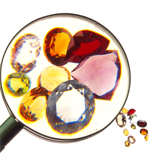Identification

How do we identify a mineral, a crystal or a gem?
Firstly, it is necessary to test its properties. Minerals have fixed or well defined compositions and recognisable crystal structures. Colour, habit and surface features can be seen but hardness, specific gravity, optical properties, atomic structure and chemical composition also help us to positively identify a specimen.
Moh’s Scale Of Hardness
Hardness is dependent upon the forces holding the atoms of the mineral together. In 1812, a scientist, F. Moh devised a scale of hardness into which all minerals can be placed. He selected ten minerals and arranged them in order so that any one mineral could be used to scratch only minerals which are less hard.
The intervals between these standard minerals is roughly equal, except that between Corundum 9 and Diamond 10. Diamond is the hardest natural material, 140 times harder than corundum.
|
|
||
1 |
 |
Talc |
|
|
||
2 |
 |
Gypsum |
|
|
||
3 |
 |
Calcite |
|
|
||
4 |
 |
Flourite |
|
|
||
5 |
 |
Apatite |
|
|
||
6 |
 |
Orthoclase |
|
|
||
7 |
 |
Quartz |
|
|
||
8 |
 |
Topaz |
|
|
||
9 |
 |
Corundum |
|
|
||
10 |
 |
Diamond |
|
|
||